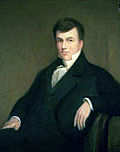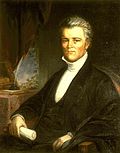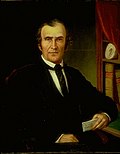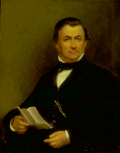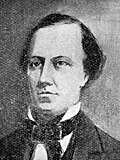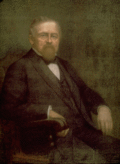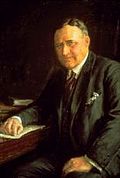List of governors of Indiana
Wikimedia list article From Wikipedia, the free encyclopedia
Remove ads
The Governor of Indiana is the chief executive of the U.S. state of Indiana. The governor is the head of the executive branch of Indiana's state government and is charged with enforcing state laws.
Governors
Governors of the Territory of Indiana
Indiana Territory was formed on July 4, 1800, from the Northwest Territory. Despite remaining a territory for nearly 16 years, it had only two governors appointed by the President of the United States before it became a state.
Governors of the State of Indiana
Indiana was admitted to the Union on December 11, 1816.
The original 1816 Constitution of Indiana provided for the election of a governor and a lieutenant governor every three years, limited to six years out of any nine-year period.[1] The second and current constitution of 1851 lengthened terms to four years and set the commencement of the governor's term on the second Monday in the January following the election.[2] Governors were allowed to serve for four years in any eight-year period,[2] but a 1972 amendment permitted governors to serve for eight years in any twelve-year period.[3] Should the office of governor become vacant, the lieutenant governor becomes governor.[4] If the office of lieutenant governor is vacant, the president pro tempore of the Indiana Senate becomes governor;[4] this has happened once, when James B. Ray succeeded William Hendricks.[5]
Remove ads
Notes
- The official site labels Eric Holcomb as the 51st governor;[6] based on this, repeat non-consecutive terms are numbered.
- Jennings resigned, having been elected to the United States House of Representatives.[8]
- Jennings was appointed a United States commissioner to conclude a treaty with native tribes on April 15, 1818; after this time, Harrison was acting as governor. However, by accepting the post, Harrison believed Jennings had vacated the seat, and thus felt he had succeeded Jennings to the governorship. The state legislature declined to confirm this, and Harrison resigned on December 18, 1818.[11]
- Hendricks resigned, having been elected to the United States Senate.[15]
- Under the 1816 constitution, governors were not capable of holding the office longer than six years in any term of nine years.[19]
- As the office of lieutenant governor was vacant, president pro tempore of the Senate Ray succeeded Hendricks.[18]
- Represented the Jacksonian faction
- Whitcomb resigned, having been elected to the United States Senate.[33]
- Under the 1851 constitution, governors were ineligible to hold the office more than four years in any period of eight years.[42]
- First term under the 1851 constitution, which lengthened terms to four years.[2]
- Lane resigned, having been elected to the United States Senate.[52]
- Morton resigned, having been elected to the United States Senate.[56]
- Baker acted as governor from October 1865 to March 1866 while Morton sought treatment for a stroke and handed over executive powers.[59]
- Represented the Republican Party
- McCray resigned following his conviction for mail fraud, and served three years in prison; he was pardoned by President Herbert Hoover in 1930.[104]
- Under a 1972 amendment to the constitution, governors were ineligible to hold the office more than eight years in any period of twelve years.[146]
- Pence won the Republican nomination, but withdrew on July 15, 2016, when Republican presidential nominee Donald Trump selected Pence as his vice presidential running mate. As Pence was barred by Indiana law from simultaneously running for both offices, he subsequently withdrew from the gubernatorial election.[159]
Remove ads
References
Wikiwand - on
Seamless Wikipedia browsing. On steroids.
Remove ads


